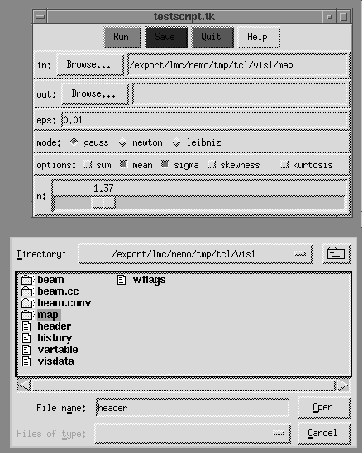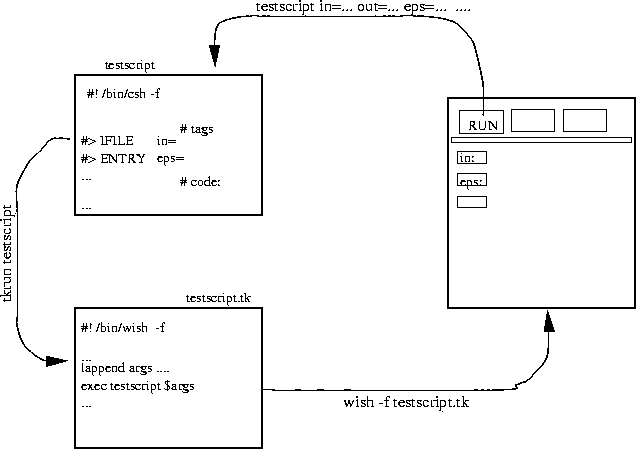 |
Next: The Mosaic Data Capture Agent
Up: Applications
Previous: Grid OCL : A Graphical Object Connecting Language
Table of Contents -- Index -- PS reprint -- PDF reprint
Peter. J. Teuben1
Astronomy Department, University of Maryland,
College Park, MD 20742, Email: teuben@astro.umd.edu
Scripting languages have often been considered the glue between individual applications, and are meant to achieve a higher level of programming.
When individual applications are (tightly) integrated into the scripting language, this offers very powerful scripts, fully graphical user interfaces and a result sometimes indistinguishable from applications. A recent example of this is the glish shell in AIPS++ (Shannon 1996). But of course the drawback of this tight integration is that applications are not always easily accessible to scripts that do not (or cannot) make use of the environment the scripting language was meant for.
Apart from the black art of handcoding, one of the traditional methods to add a GUI to an application is using automatic GUI builders. This has the advantage that application code and user interaction code are more cleanly separated, but this sometimes also limits the flexibility with which the code can be written.
This paper presents a simple implementation where the style of the underlying application is batch oriented, and in fact can be written in any language. The user interface must be cleanly defined in a set of parameters with optional values (e.g., named ``keyword=value'' pairs). Once the input values have been set, the application can be launched, results can be captured and presented in any way the script or application decides.
The GUI that is created will provide a simple interface to a program that is spawned by the GUI. This program must have a well defined Command Line Interface (CLI), in the current implementation a `` keyword=value'' interface. Equally well, a Unix-style ``-option value'' could have been used (cf. Appleton's parseargs package). The GUI builder, a small 600 line C program called tkrun, scans the script for special tags (easily added as comments, which automatically make the script self-documenting), and creates a Tcl/Tk script from which the shell script itself (or any application of choice with a specified CLI) can be launched (see Figure 2 for a schematic).
The added power one gets with this interface builder is the simplified re-execution of the script, which gives the user a powerful tool to quickly examine a complex parameter space of a particular problem.
The input script must define a set of parameters, each with a keyword, an optional initial value, a widget style, usage requirements and one line help. The keyword widget style can be selected from a small set of input styles that standard Tcl/Tk provides (such as generic text entry, file browsers, radio buttons, sliders etc.)
 |
The current implementation has been tested under Tcl/Tk 7.6 as well as 8.0, but is expected to move along as Tcl/Tk is developed further. For example a more modern widget layout technique (grid instead of pack) should be used. Also keywords cannot have dependencies on each other, for example it would be nice to ``grey out'' certain options under certain circumstances, or allow ranges of some keywords to depend on the settings of others.
Here is an example header from a C-shell script with which Figure 1 was made. Note that the script must supply a proper ``keyword=value'' parsing interface, as was done with a simple foreach construct here. The latest version of tkrun is available through the NEMO package.
#! /bin/csh -f
# :: define basic GUI elements for tkrun to extract
#> IFILE in=
#> OFILE out=
#> ENTRY eps=0.01
#> RADIO mode=gauss gauss,newton,leibniz
#> CHECK options=mean,sigma sum,mean,sigma,skewness,kurtosis
#> SCALE n=1 0:10:0.01
# :: some one liners
#> HELP in Input filename
#> HELP out Output filename (should not exist yet)
#> HELP eps Initial (small) step
#> HELP mode Integration Method
#> HELP options Statistics of residuals to show
#> HELP n Order of polynomial
# :: parse named arguments
foreach a ($*)
set $a
end
# :: actual start of code
echo TESTSCRIPT in=$in out=$out eps=$eps mode=$mode options=$options n=$n
# :: legacy script can be inserted here or keyword
# :: values can be passed on to another program
 |
I would like to thank Frank Valdes and Mark Pound for discussing some ideas surrounding this paper, and Jerry Hudson for his Graphics Command Manager FLO.
Appleton, Brad (parseargs, based on Eric Allman's version)
Judson, Jerry (FLO: a Graphical Command Manager)
Ousterhout, John, 1994, Tcl and the Tk Toolkit, Addison-Wesley
Shannon, P., 1996, in Astronomical Data Analysis Software and Systems V, ASP Conf. Ser., Vol. 101, eds. G. H. Jacoby and J. Barnes (San Francisco, ASP), 319
Teuben, P.J., 1995, in Astronomical Data Analysis Software and Systems IV, ASP Conf. Ser., Vol. 77, eds. R. A. Shaw, H. E. Payne & J. J. E. Hayes (San Francisco, ASP), 398
Next: The Mosaic Data Capture Agent
Up: Applications
Previous: Grid OCL : A Graphical Object Connecting Language
Table of Contents -- Index -- PS reprint -- PDF reprint